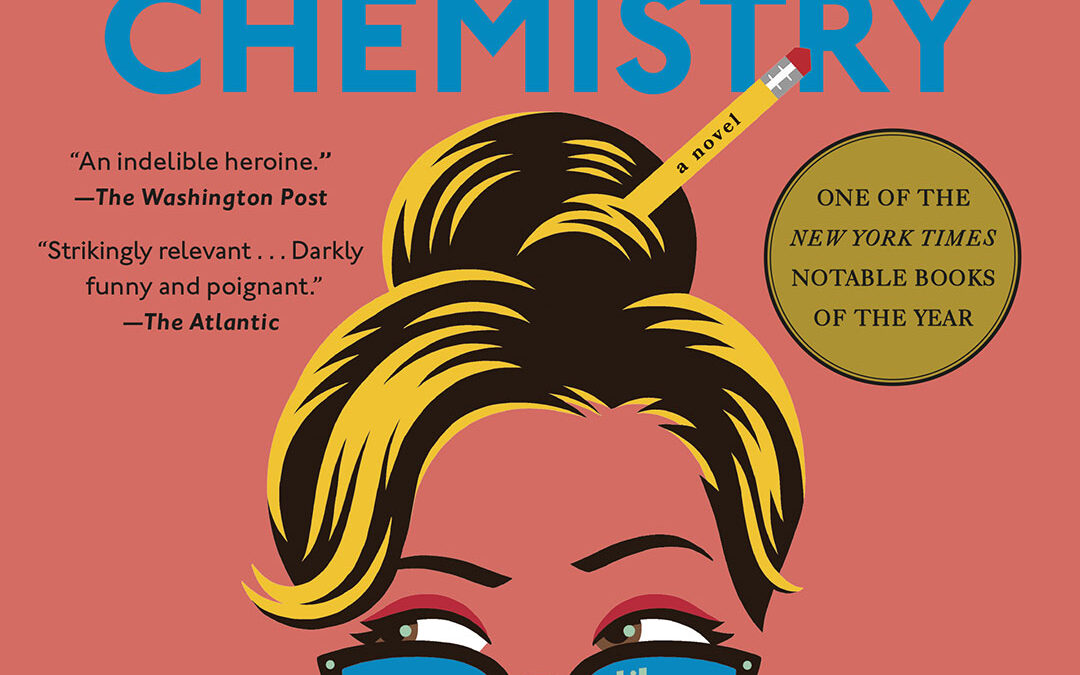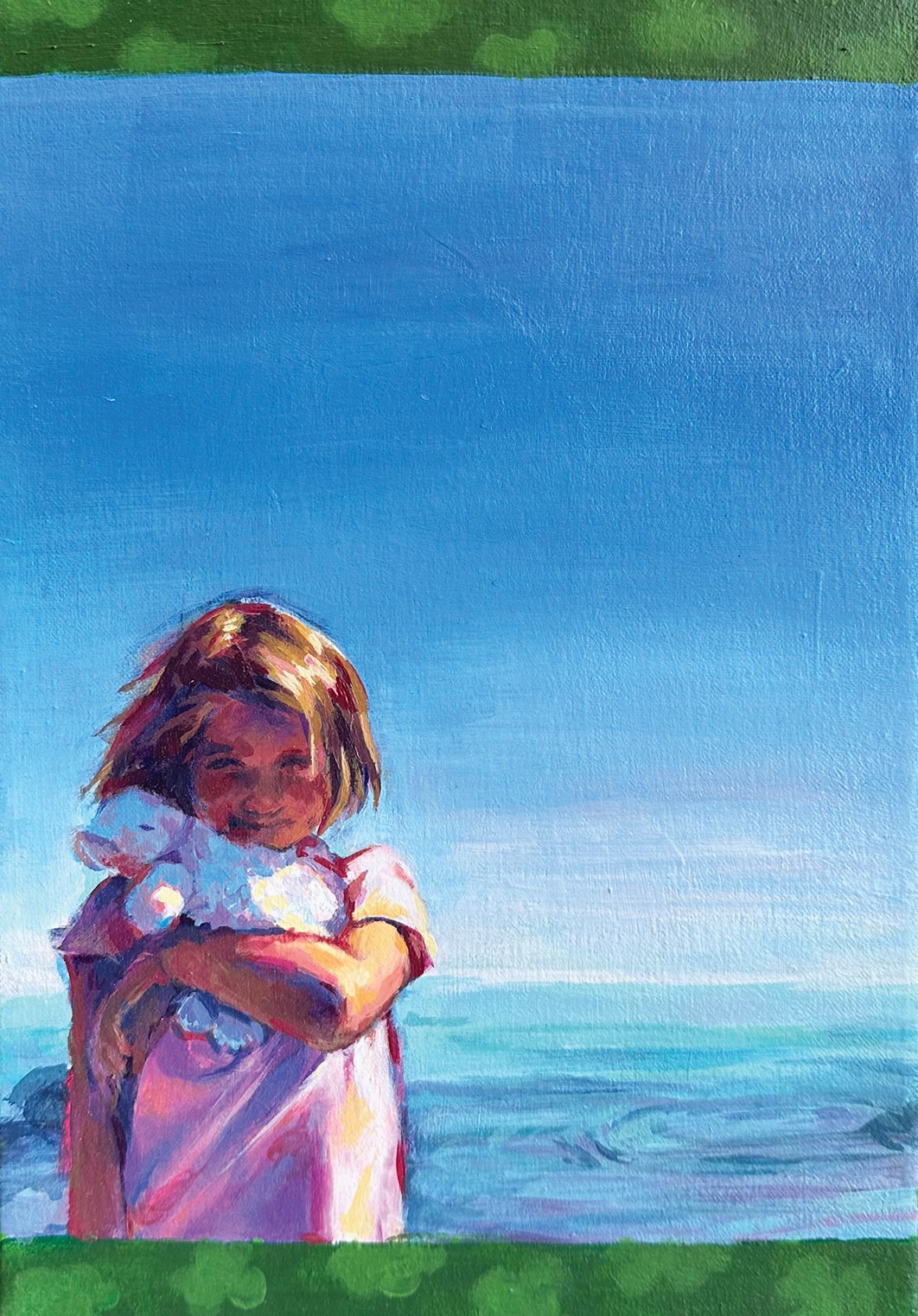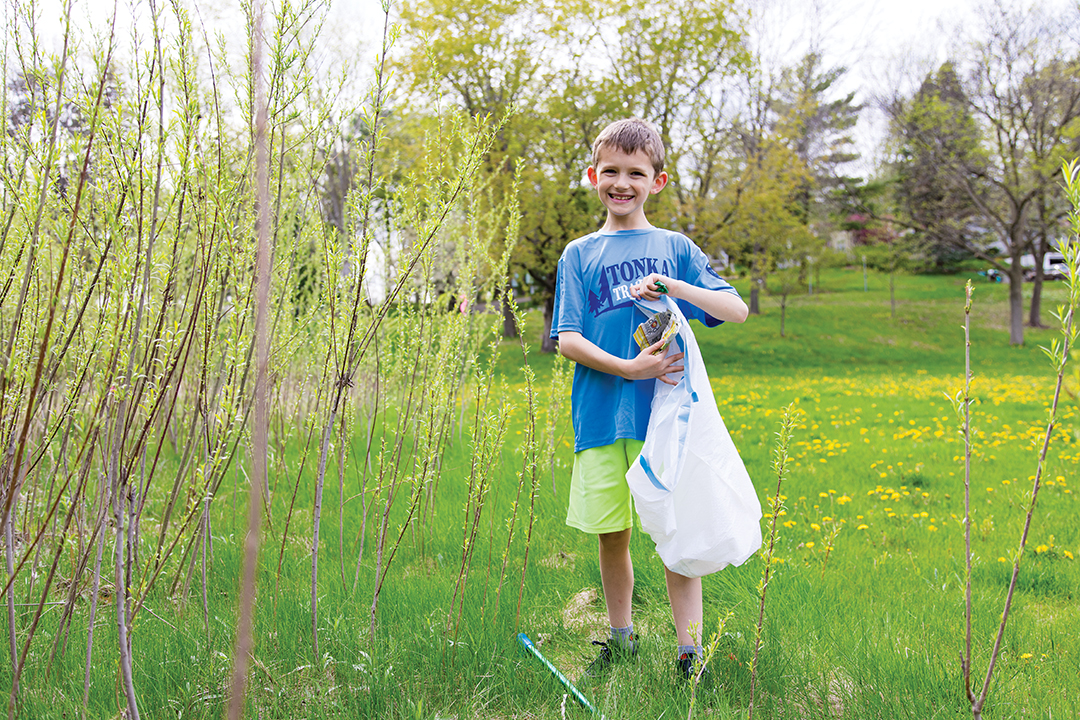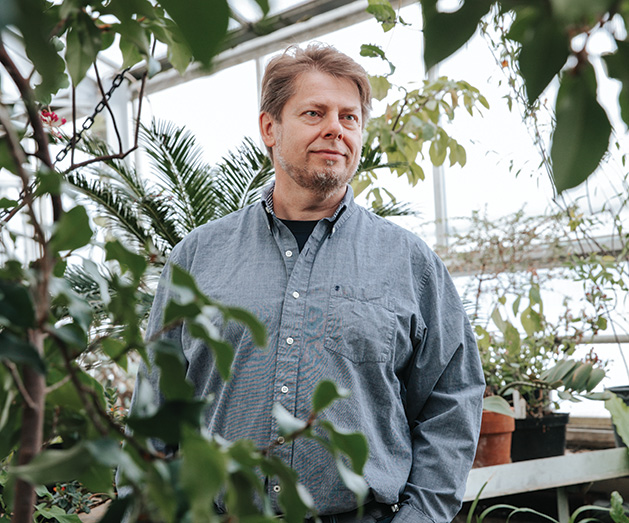
Photo: Rachel Nadeau
At Cedar Creek Ecosystem Science Reserve, Frank Meuschke combines science with art.
Artist Frank Meuschke has lived all over the country—from New York City to Maine, Oregon and New Mexico. Now based in Minnetrista, Meuschke (pronounced “moosh-ka”) says he hasn’t found a place that he’s loved more than Minnesota.
Meuschke began his fine arts career with painting, attending the New York School of Visual Arts and State University of New York in the early ‘90s, and received his Master of Fine Arts in 2000 from New Mexico State University. He’s completed residencies at the MacDowell Colony, the Weir Farm Art Center and the Henry Street Settlement. Meuschke’s also served at the Dean of the Skowhegan School of Painting and Sculpture.
Now serving as an education specialist teaching photography at the Minnesota Landscape Arboretum and as an MFA advisor as the Minneapolis College of Art and Design, Meuschke’s certainly been involved in the Minnesota art scene.
But it wasn’t until he moved to Minnesota, where his wife, artist Betsy Alwin, grew up, that he began delving deeper into the world of photography. Though he’d always played around with photographs, his first gallery showing wasn’t until 2016—and his fourth, Invisible Present, didn’t occur until 2019 following his one-year artist residency at the Cedar Creek Ecosystem Science Reserve.
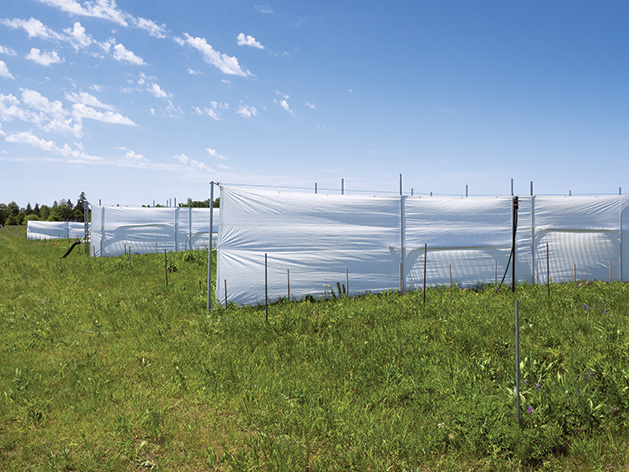
Water Manipulation, Biodiversity and Climate (BAC) Experiment | The BAC (biodiversity and climate) experiment examines the interactive effects of global warming and biodiversity on prairie ecosystems. The experiment consists of 38 plots containing varying levels of biodiversity (1, 4, 16 or 32 prairie species).
Cedar Creek
Connected to the University of Minnesota, the Cedar Creek Ecosystem Science Reserve is a nine-square-mile biological field station, home to many different biomes (ecosystems and species) found throughout North America. According to the Cedar Creek website, the research center looks to consider the long-term effects of human-driven environmental changes through different types of experiments; most notably, the facility’s burning experiments.
“I didn’t know about [Cedar Creek] at all, since I’m not from Minnesota,” Meuschke says. “I found it on Google Maps, and I needed a new place to work, so I cold-emailed Caitlin Barale Potter, the education and community engagement coordinator, about working on the site.”
Sure enough, Potter responded. A couple of months later, she sent another email—detailing the new artist in residence program developed at Cedar Creek. The program, named Cedar Creek Reflections: Arts at the Reserve, invites artists, including photographers, painters, musicians, dancers and writers, to investigate the intertwining of science, nature and humanity.
“Following the same pathway for reviewing proposals for a new research project onsite, what we look for in arts applicants is a manageable project that feel unique to Cedar Creek,” Potter says. “A piece of art or body of work that explores our research, scientists, experiments, manipulated landscape or something else that can’t be easily explored elsewhere.”
Artists are granted access to the research site, habitats and experiments for up to a year, and provided with the opportunity to interact with researchers and students on-site. Residents are also provided with a one-bedroom house on the property for overnight stays, if desired. Meuschke stayed at the site several nights a week for a year, beginning in March 2018.
“From what I understood, Cedar Creek was a research center … I didn’t understand what the place was,” Meuschke says. “Caitlin [Potter] let me know that it’s one of the best places you can be for ecology, as it’s super important historically and currently.”
The importance of Cedar Creek isn’t to be underestimated, Meuschke explains. “I was there one Sunday and this family [visiting] from China drove in and wanted to talk to someone about the land. It turns out that [the father] learned about Cedar Creek in grade school in Beijing and made a detour to come visit. I thought ‘So they learned about this place in Beijing, but no one here knows about it?’”
For the Cedar Creek team, inviting artists to their land has been just as exhilarating. “It has been thrilling to our scientists, staff and larger community to see how [the art] has translated into finished projects,” Potter adds. “The new light that these artists have shed on our scientific work has underscored the value of the artist in residence program … Everyone involved has emerged with a new and enriched perspective.”

Prescribed Burn, Savanna, Spring | Each spring Cedar Creek ESR conducts a series of prescribed burns within its boundaries as part of its long-term research and land management programs. Controlled burns on 900 acres of oak savanna, prairies, and research units are managed by staff under the supervision of trained personnel with many years of prescribed burning experience.
Meuschke’s Work
Fairly uncertain about what his work was going to mean, Meuschke set out on his year-long journey to discovering how to tell the story of Cedar Creek—“I knew how to structure my variables (aperture, focal length, etc.) … But I didn’t have any sense of what [the art] would be,” he says.
Figuring out what Cedar Creek is, and the meaning of his photographs, was quite the journey.
“If I could sum it up (the title of the show is Invisible Present), it’s to some degree a mystery,” he explains. “That ecology is hard to represent, it’s an invisible thing. The mystery of this place, that’s so closed off, it’s taken on its own cultural landscape.”
Invisible Present showed at the Rosalux Gallery in Northeast Minneapolis (among other galleries), and according to Meuschke’s personal website, questions the “abstract principle and the binary of pure wilderness or anthropogenic despoliation by placing human activities into the landscape image.”
Meuschke never intended his images to be “documentary,” but instead just a “landscape experience.” With 8,500 images, he had quite the task choosing pieces for his show. “I reduced it to 100 and made a list. After that, I just couldn’t see anymore,” he says. “So, the gallery director in Waseca helped … and I also asked my wife. It’s great to have another eye [look at my work].”
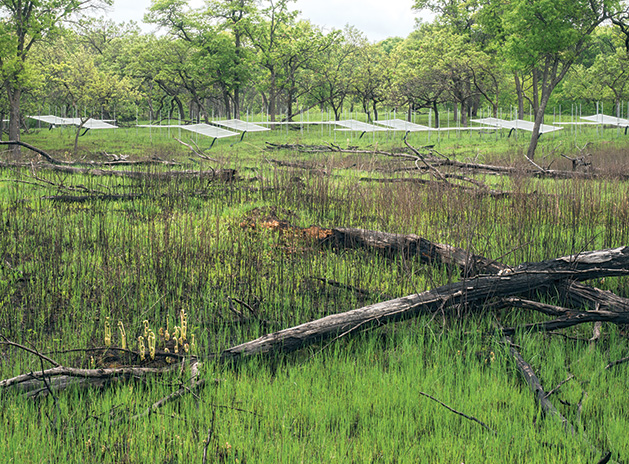
Water Manipulation, International Drought Experiment: Cedar Creek Savanna | The International Drought Experiment is a highly coordinated experimental worldwide network of drought experiments aimed at assessing differential sensitivity of terrestrial ecosystems to extreme drought.
One of his favorite images, “Water Manipulation, International Drought Experiment: Cedar Creek Savanna,” portrays the ideal of an experience. Before becoming a photographer, he would paint nature scenes and urban parks, and the green in the photograph immediately reminded him of his own aesthetic. But the conundrum of the photo is also appealing —“There’s a lot of linework going on with the poles; it’s very mysterious. It’s close enough to identify, but far enough to not find clues to what’s going on. So, this became an iconic picture of that space.
“I came to look at [the photographs] with a sense of mystery … and a little bit of hauntedness in a way. It led to me where [the project] lands,” Meuschke adds.
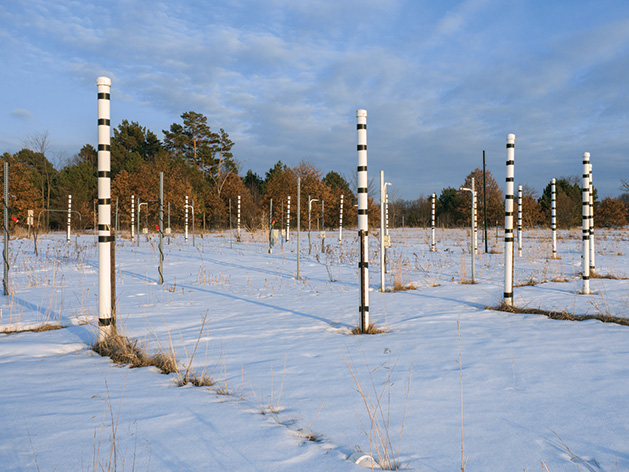
Experiment 141: Biodiversity CO2 and Nitrogen (BioCON), Winter | BioCON is one of only three studies in the world capable of providing long-term evidence on joint effects of CO2 and nitrogen on biodiversity and ecosystem function.
Weaving Arts & Science
Showcasing the relationship between the emotional aspect of climate change and the landscape was Meuschke’s main priority, after having discovered his goal nearly 2/3 of the way into his journey.
“Climate change causes anxiety for people and landscape is that place where we project what we feel about nature,” Meuschke says. “I feel that the landscape provokes this anxiety now instead of reassuring us. Before it was bounty, comfort, pleasant isolation and positive things. Now it’s like everything is ruined and that anxiety seems to be everywhere.”
Focusing on that relationship gave Meuschke the focal point for his show. Though there’s hesitation to polarize Cedar Creek, he began to see Cedar Creek as a general positive when interacting with the environment and wanted to showcase that in a positive light.
“When artists aestheticize climate change (oil spills, glaciers, etc.) as art, I’m not sure that helps us in any way,” he says. “I tried to create landscape images that are counter to the common images that we see, I wanted to put us in the picture.”
Though you won’t find a lot of people at Cedar Creek, Meuschke’s photographs tend to make the atmosphere feel full—and even caught details that the Cedar Creek team hasn’t noticed.
“His work captured a different side of Cedar Creek than most of the scientists here have experienced,” Potter says. “Although the experiments, landscapes, infrastructure and equipment Frank captures in his photographs are run-of-the-mill to those of us who work them every day, he somehow manages to catch them in a different light.”
Displaying the significance of Cedar Creek was of the utmost importance for Meuschke. But he also hopes that his audience picks up on the importance of combining science with art.
“In our culture, we see science and art as very different,” Meuschke says. “Science is of the mind. It’s rational and sound. Art is of the heart. It’s passion. And as silly as those things are, they are there. So, we reach a completely different audience in a completely different way. And we’re at the point where we need that.”
View Frank Meuschke’s work at frankmeuschke.com. To learn more about the Cedar Creek artist in residence program, go to cedarcreek.umn.edu/artistinresidence.
Frank Meuschke
Instagram: @frankmeuschke
Cedar Creek Ecosystem Science Reserve
2600 Fawn Lake
Drive NE, East Bethel
612.301.2600

